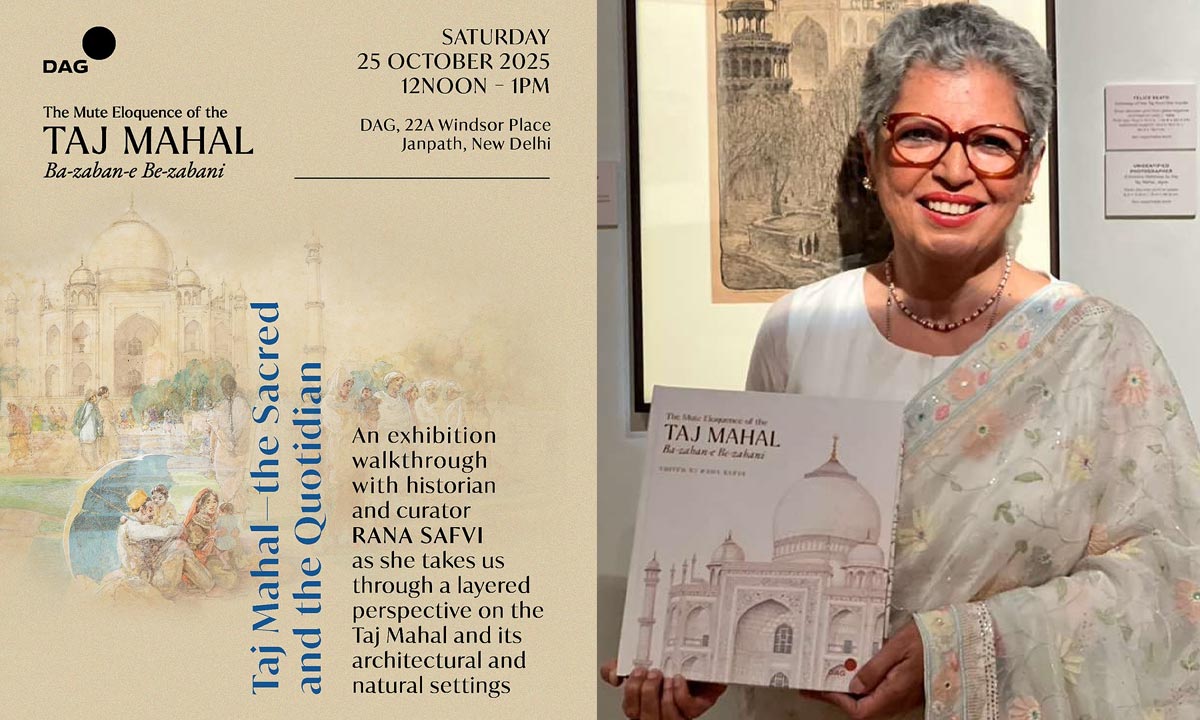
The radiant marvel of white marble rising from the banks of the Yamuna is the Taj Mahal. It is widely recognized as the monument of eternal love built by Emperor Shah Jahan for his wife Mumtaz Mahal. Apart from the tales and stories attested to it, a close examination of the structure reveals a complex and dynamic structure that is an unparalleled masterpiece. This masterpiece speaks through an architectural silence; this concept is called “mute eloquence,” or ba-zaban-e be-zabani. This forms the core of repositioning the Taj as the vector of history, theology, and imperial ambitions.
On display from 25 October to 6 December 2025 at DAG, New Delhi, is a presentation of over 200 works, including the Company School paintings, photographs, postcards, and modern interpretations, all focused on India’s most iconic mausoleum. Curated by historian and writer Rana Safvi, the exhibition invites viewers to consider the Taj as a “speaking” agent.
Conceptualization
The very notion of the Taj Mahal speaking is not contemporary; Rana Safvi borrows the words of the Mughal court chronicler Abdul Hamid Lahauri, who described the Taj Mahal, referred to as the Rauza-i Munawwara (The Illumined Tomb), as possessing the mute eloquence or ba-zabān-e be-zabānī. In Lahauri’s words, “Verily our relics tell of us, speak with mute eloquence of His Majesty’s God-given aspiration and sublime fortune.” The main motive of bringing this context to life is to project the Taj as a hub of layered architecture with nuanced geometry, inscription, gardens, and everything that one can think of when medieval era architecture flashes in our minds. Simultaneously, it paves a path for the visitors to go beyond the visitor’s gaze and gain knowledge about the undercurrents associated with the building.
Decoding the Architectural Language
View this post on Instagram
The depth of the Taj’s eloquence lies in its architectural and ornamental choices, which fuse Persian, Islamic, and Indian traditions to create a holistic structure. Structurally, the Taj is deeply rooted in Islamic Cosmology and was conceived as a replica of Mumtaz Mahal’s promised house in paradise. The entire complex of this grand monument is a metaphorical representation of the celestial garden, adorned with a charbagh (four-part garden) setting. This displays a seamless integration of the Quranic inscriptions and the rewards awaiting the faithful in paradise. The Taj is also a physical repository of extremely intricate calligraphy that was executed by Amanat Khan (Abdul Haq Shirazi) in inlaid jasper. The calligraphy is so masterfully carved that the uniformity of size and legibility from the ground is properly ensured throughout the structure. This inlay of the Qur’anic inscriptions embedded in the mausoleum links the building to Islamic ideas of paradise and transcendence. The use of floral motifs in pietra dura inlay work on cenotaphs, screens, and walls symbolises both the garden-paradise motif and a remembrance of death and love.
The Untold Narratives
Scholarly research has increasingly highlighted the overlooked facets of the Taj Mahal complex, moving beyond the central love story to expatiate its social and economic context. One of the most underexplored niches is the relationship between the monument and the commercial pulse of the city that houses it. The Taj Ganj, a historic settlement and the neighborhood directly south of the Taj Mahal, was once a vibrant market quarter and played a crucial role in the maintenance of the logistical and economic ecosystem supporting the monument. The Taj Ganj functioned as the immediate socio-economic hinterland that once integrated the lives around the Taj. Therefore, the majestic construction not only functioned as a private family monument or a tomb of the royals, but it also served as an imperial statement among the public, demonstrating the Mughal prowess and wealth. Through this exhibition, DAG aims to surpass the barriers veiling this information and wishes to drive the visitors back to a finely layered historical moment.
Where Does The Taj Stand In Popular Imagination?
Straight from its inception, the Taj Mahal has held a magnetic field around it that constantly attracted fascination across centuries, penetrating multiple cultures and nations. The Bengali Nobel Laureate Rabindranath Tagore famously encapsulated its sentimental power, describing it as “a teardrop on the cheek of time.” The journey of the Taj Mahal in visual culture has been meticulously documented by a plethora of artists. The intricate pietra dura details are well documented through the Company School Paintings by Agra-based artists. Colonial era photographers like Samuel Bourne and other foreign artists, such as Thomas Daniell, contributed to its global fame.
Important Notes on the Event
| Event Detail | Description |
|---|---|
| Exhibition Title | The Mute Eloquence of the Taj Mahal (Ba-zaban-e Be-zabani) |
| Curator | Historian and author Rana Safvi |
| Dates | October 25, 2025 – December 6, 2025 |
| Venue | DAG (formerly Delhi Art Gallery), New Delhi, India |
| Scope | Over 200 works, including Company School paintings, colonial photographs, modern Indian art, and archival documents. |
| Key Focus | Positioning the Taj as a ‘speaking’ agent, exploring its theological meaning, and highlighting overlooked aspects like Taj Ganj and the role of other women in the court. |
Key Highlights
- The curatorial premise: treating the Taj Mahal as a “speaking” structure, despite its silence.
- Rare archival photographs and early prints (18th–19th century) showing the monument’s evolving visual reception.
- A focus on the lesser-seen “Taj Ganj” market zone and its architectural/commercial interplay.
- Works by modern Indian artists (e.g., Abanindranath Tagore) and foreign artists capturing the monument from diverse perspectives.
- A linked publication (book) edited by Safvi and contributors that dives deeper into these themes.
Why This Exhibition Matters?
The exhibition invites the viewers to pause and reconsider what we think we know. The Taj Mahal is often reduced to two things: a monument of romantic love and a must-see tourist cliché. This exhibition insists on the Taj Mahal’s complexity, perspective on devotion, paradise imagery, and commerce, and political ambition attests to it. By doing so, it enriches our understanding of architecture, memory, and cultural symbolism.
Takeaway
The temptation to view the Taj Mahal simply through the lens of a beautiful, tragic love story does not do justice to its historical and artistic genius. To call it merely a monument of love is to reduce a whole composition to a single note. The curatorial choice aims to break these little-known preconceived tales of the Taj and transform the monument into something more than just a ‘popular place to click a picture while pinching the dome’.
Another side to this story is, a super reliance on “mute eloquence” poses a risk of romanticising silence and neglecting the human labour. Beyond this silence, the Taj Mahal is a loud cultural boom, a heritage site, and a crowded tourist locus. This exhibition welcomes a recalibration as it is a standalone stone-and-marble treatise on power and piety that defined the Mughal Empire. Thus, the silence of the Taj is not a barrier but an invitation to integrate it with the contemporary visual tradition.







